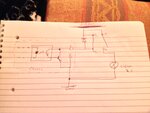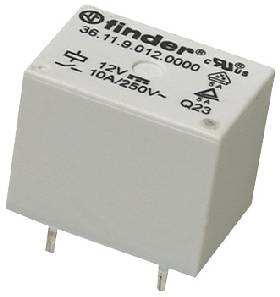scmojks
Newbie level 5
Attached is a section from a manual from an industrial camera.
The following is also a snippet from the manual:
The camera is equipped with one physical output line designated as Output Line 1. The output line
is accessed via the 6-pin connector on the back of the camera.
The output line is opto-isolated.
recommended operating voltages. The absolute maximum voltage is +30.0 VDC. The maximum current allowed through the output circuit is 50 mA.
A low output signal from the camera results in a non-conducting Q1 transistor in the output circuit.
Voltage Significance
< +3.3 VDC The I/O output may operate erratically.
+3.3 to +24 VDC Recommended I/O output voltage.
+30.0 VDC Absolute maximum; the camera may be damaged, if the absolute maximum is exceeded.
A high output signal from the camera results in a conducting Q1 transistor in the output circuit.
I want to switch a 24VDC relay coil with output line 1 and was wondering where do i connect A1 & A2 of the relay so that when the ouptut is turned on the relay will switch on,
Also if using a 24VDC 2.1 A do i need a resistor to limit the current in the circuit to 50mA to prevent damage to the camera?
i would intend to use a solid state relay
Any advise would be appreciated
Thanks
The following is also a snippet from the manual:
The camera is equipped with one physical output line designated as Output Line 1. The output line
is accessed via the 6-pin connector on the back of the camera.
The output line is opto-isolated.
recommended operating voltages. The absolute maximum voltage is +30.0 VDC. The maximum current allowed through the output circuit is 50 mA.
A low output signal from the camera results in a non-conducting Q1 transistor in the output circuit.
Voltage Significance
< +3.3 VDC The I/O output may operate erratically.
+3.3 to +24 VDC Recommended I/O output voltage.
+30.0 VDC Absolute maximum; the camera may be damaged, if the absolute maximum is exceeded.
A high output signal from the camera results in a conducting Q1 transistor in the output circuit.
I want to switch a 24VDC relay coil with output line 1 and was wondering where do i connect A1 & A2 of the relay so that when the ouptut is turned on the relay will switch on,
Also if using a 24VDC 2.1 A do i need a resistor to limit the current in the circuit to 50mA to prevent damage to the camera?
i would intend to use a solid state relay
Any advise would be appreciated
Thanks






